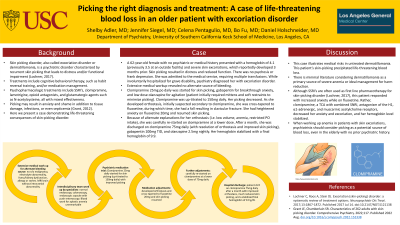Collaborative and Integrated Care
(065) Picking the right diagnosis and treatment: A case of life-threatening blood loss in an older patient with excoriation disorder


Jennifer Siegel, MD (she/her/hers)
Resident Physician
University of Southern California
Los Angeles, California
Shelby Adler, MD
Psychiatry Resident
University of Southern California
Santa Monica, California- CP
Celena Pentagulio, MD
Psychiatrist
LAGMC/USC
Los Angeles, California 
Bo Fu, MD
CL Fellowship Program Director
USC Keck School of Medicine
Los Angeles, California- DH
Daniel P. Holschneider, MD
Professor
University of Southern California
Los Angeles, California
Presenting Author(s)
Co-Author(s)
Background Case While involuntarily hospitalized for grave disability, psychiatry diagnosed her with excoriation disorder. Extensive medical workup revealed no alternate source of bleeding, malignancy, electrolyte, liver or kidney abnormalities, allergies or rashes. She had a normal endoscopy, colonoscopy, and endoscopic capsule with push enteroscopy; blood work for aplastic anemia was unremarkable. Clomipramine 25mg po daily was started for skin picking, gabapentin for breakthrough anxiety, and low dose olanzapine for agitation (patient initially required mittens and soft restraints to minimize picking). Clomipramine was up-titrated to 150mg daily. Her picking decreased. As she developed orthostasis, initially suspected secondary to clomipramine, she was cross-tapered to fluoxetine, during which time, she had a fall resulting in clavicular fracture. She had heightened anxiety on fluoxetine 20mg and resumed skin picking. Because of alternate explanations for her orthostasis (i.e. low volume, anemia, restricted PO intake), she was carefully re-started on clomipramine at a lower dose. After a month, she was discharged on clomipramine 75mg daily (with resolution of orthostasis and improved skin picking), gabapentin 100mg x3/day, and olanzapine 2.5mg nightly. Her hemoglobin stabilized with a final hemoglobin of 9.9. Discussion References Grant JE, Chamberlain SR. Characteristics of 262 adults with skin picking disorder. Comprehensive Psychiatry. 2022;117. Published 2022 Aug. doi.org/10.1016/j.comppsych.2022.152338
Skin picking disorder, also called excoriation disorder or dermatillomania, is a psychiatric disorder characterized by recurrent skin picking that leads to distress and/or functional impairment (Lochner, 2017). Treatments include cognitive behavioral therapy, such as habit reversal training, and/or medication management. Psychopharmacologic treatments include SSRI’s, lamotrigine, opioid antagonists, and glutamatergic agents such as N-acetylcysteine, all with mixed effectiveness. Picking may result in anxiety and shame in addition to tissue damage, infections, or even septicemia (Grant, 2012). Here we present a case demonstrating life-threatening consequences of skin-picking disorder.
A 62-year-old female with no psychiatric or medical history presented with a hemoglobin of 4.1 (previously 3.5 at an outside facility) and severe skin excoriations, which reportedly developed 3 months prior. Skin picking resulted in distress and reduced function. There was no psychosis or frank depression. She was admitted to the medical service, requiring multiple transfusions.
This case illustrates medical risks in untreated dermatillomania. This patient’s skin-picking precipitated life-threatening blood loss and critical orthostasis. There is minimal literature considering dermatillomania as a primary source of severe anemia or ideal management for harm reduction. Although SSRI’s are often used as first line pharmacotherapy for skin-picking disorder (Lochner, 2017), this patient responded with increased anxiety while on fluoxetine. Rather, clomipramine, an SNRI with additional antagonism of the H1, α1-adrenergic, and muscarinic acetylcholine receptors, decreased her anxiety and excoriation, and her hemoglobin level stabilized. When working up anemia in patients with skin excoriations, psychiatrists should consider picking as a potential source of blood loss, even in the elderly with no prior psychiatric history.
Lochner C, Roos A, Stein DJ. Excoriation (skin-picking) disorder: a systematic review of treatment options. Neuropsychiatr Dis Treat. 2017;13:1867-1872. Published 2017 Jul 14. doi:10.2147/NDT.S121138
Presentation Eligibility: Not previously published or presented
Diversity, Equity, and Inclusion: There is sparse literature investigating excoriation disorder in people of color, which negatively impacts diagnosis and treatment rates across various racial-ethnic groups (Valle, S et al, Psychiatry Research, 2022). In particular, research has shown that self-identified Black, Asian, or Minority Ethnic with skin picking disorder not only spend more time picking per day than self-identified white individuals, but they are also less likely to receive treatment (Grant, J et al, Comprehensive Psychiatry, 2021). This case report aims to shed light on the importance of recognizing skin picking as a diagnosis and the severe consequences of untreated excoriations.

